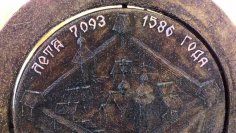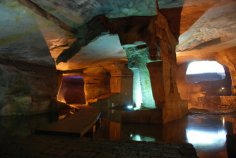
Peter the Great is the greatest figure in Russian history, his reorganization of the state allowed the creation of a strong, powerful country. However, more and more often in scientific circles they are beginning to look at this figure differently. There is a theory that it was not the Peter who returned from his trip to Europe, the emperor was replaced, and his place was taken by an impostor who did everything possible to destroy Russian history.
This theory seems very far-fetched and more like a legend. After all, history is a science as precise as mathematics. And there is no need to think otherwise, real history is based solely on facts, data confirmed by historical documents or artifacts.
It is enough to conduct a DNA analysis, and it will become obvious that the theory of the substitution of Peter I has no basis. Another aspect of the Russian reformer's activity looks interesting. Why does he encourage Germans to write the history of the Russian state, who are not only far from the cultural tradition of our people, but do not even understand the language of the country and will not be able to read ancient chronicles?
Why did Peter burn all the chronicles that had been brought from all over the country to St. Petersburg?
There are various answers to these questions. Supporters of classical history answer that the emperor wanted uniformity and a single history, but the motives and goals pursued by the autocrat remain inexplicable.
Alternative history experts will answer these questions in the spirit of the theory that the Tsar was replaced and all that.
Let us try to figure this out ourselves, based on facts that can be found freely available on the Internet and which modern historical science is in no hurry to publish, not because there is some kind of global conspiracy, but because scientists themselves do not know how to explain it.
In 1977, burials were discovered in China that were very well preserved. The story of the discovery of this crypt is connected with an accident. After preliminary work on clearing the burial was carried out, Chinese scientists found several skeletons that clearly did not belong to the Asian type of people. The corpses were very well preserved, as a result of natural mummification. All those buried in the crypt had light, blond hair, straight noses, and wide eye sockets.
But the strangest thing was that not far from this crypt, a burial of people who were killed in the same way, their hands and heads were cut off, was discovered. But the most interesting thing is that in this common grave there were only representatives of Asian peoples.
Two burials were made at the same time, most likely it was a mass execution in honor of the dead people.
Of course, one can say that this is just some kind of historical misunderstanding, you never know what can happen on earth. However, in the following decades, several more similar burials were found.
In 1990, in the same region, which is located near the Great Silk Road, a huge burial site was discovered. Among the dead, all people of Asian appearance. Subsequently, the Chinese government banned research in this region, all excavations ceased, and scientists were recalled from this region.
In 1987, the ruins of a small wooden fortress were found in the Chelyabinsk region, but underneath them were the ruins of a stone city. The ruins were dated to the 3rd century BC. Imagine that there was already a stone city on the territory of modern Russia, while Europeans were still running through the forests, fighting with the Roman legions. In one of the miraculously preserved chronicles, written on birch bark, there are references to several stone cities of the Slavs. One of them is located in an area very similar to the landscapes where the ruins were discovered. In the chronicle, this city is called Arkaim.
In 2011, archaeologists discovered adits in the Urals that went several hundred kilometers deep into the mountains. Having studied only a few percent of these underground passages, archaeologists discovered a real copper smelting plant and several workshops for the manufacture of not only weapons and armor, but also household items.
In 2013, Italian archaeologists near Rome discovered a pyramid carved directly out of the rock. The pyramid is located in a cave, the height of the structure is 15 meters. Having penetrated inside the room, the remains of dishes were found, which had an unusual pattern, later it was possible to find out that the graphic images on the dishes are very similar to the ornament of dishes from the ancient Slavic city of Arkaim.
In 2009, during restoration work in the center of Rome. Due to soil displacement in the excavated pit, the soil sank, revealing the entrance to the collapsed room. Inside, a room was discovered, the walls of the room were decorated with various drawings, which are very similar to the ornaments found on the dishes in the city of Arkaim and Chinese burials. The room resembled a hemisphere, when people went down the steps into the room itself, it turned out that it was equipped with a rotating floor that turned 360 degrees.
In 2014, a similar grotto with a rotating floor was discovered in France, but bad weather conditions destroyed the paintings.
In addition, various artifacts related to the history of the Slavic peoples are found in the world every year. The aura of finds of objects, jewelry, weapons, buildings is very huge, which allows us to talk not about the nomadic way of life of the Slavs, but that it was permanent, sedentary.
Thus, all over the continent there are artifacts that can be linked to the Slavic people. However, the other side of all these discoveries is interesting. Most of them remain little known, that is, they are not advertised to the public.
Why the scientific world does not take such significant artifacts into account remains a mystery. I would not like to become a conspiracy theorist, but still, there is something rational in this. The more discoveries that testify to the high technological and social development of the people who were able to leave such significant artifacts, the stranger it seems that Peter I wanted to rewrite the history of his people.





